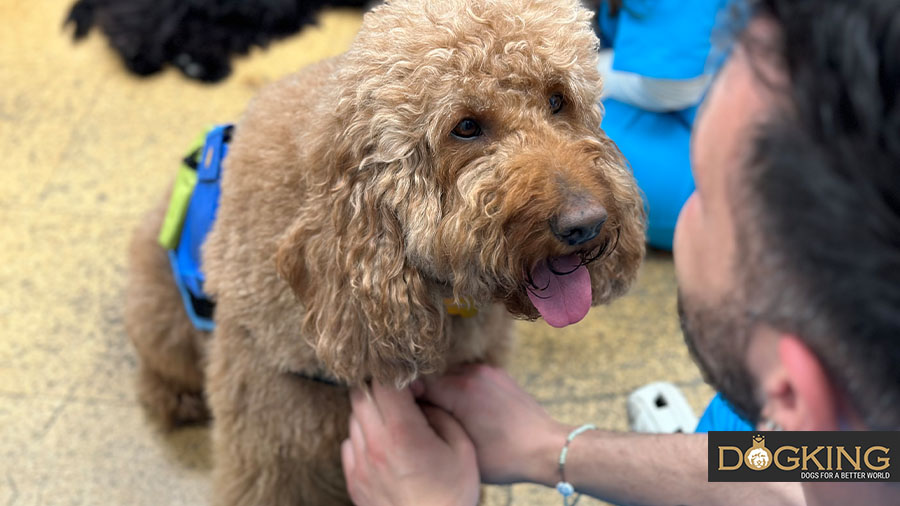Can your dog know that you are sick?
The incredible and precise sense of smell surprises scientists around the world.

THE SUPERPOWER OF DOGS: SMELL
Approximate reading time: 6 minutes
Surely you have ever read or heard stories about dogs that were able to find out that their owners were suffering from an illness before they even knew it. It is no secret that these animals have a privileged sense of smell, with 200 million receptors - compared to 5 million for humans - that allow them to capture subtle aromas that are totally imperceptible to us. But what does science say about dogs' ability to detect diseases in people? What's true about the belief that your dog can tell if you're sick?
Table of contents
1. How do dogs detect diseases in people?
2. What diseases can a dog detect?
4. Can all dogs diagnose diseases?
1. How do dogs detect diseases in people?

Science has demonstrated that certain pathologies, such as cancer, infections or hyperglycemia, cause changes in the body odour of those who suffer from them. However, these are volatile organic compounds that are undetectable to the human nose but not to the dog's nose, which can perceive and isolate these changing chemical substances thanks to its powerful dual sense of smell.
In addition to their powerful nose, these incredible animals have the vomeronasal organ, located in the palate and responsible for capturing these volatile particles. This way, using their strong olfactory tool, dogs can smell disease in a patient’s urine, breath, sweat and faeces even before a diagnosis exists.
2. What diseases can a dog detect?

There is scientific evidence of dogs that have detected diseases such as cancer, epilepsy, infections (mild or severe), narcolepsy, migraine, anxiety, malaria, Parkinson’s, sugar spikes or kidney failure, among others. They can also smell pathologies in other dogs (such as detecting cancer through the smell of their saliva) or even in deer (a study showed they could diagnose chronic wasting disease by smelling their faeces).
In all these cases, the experiments were carried out with dogs specifically trained for this purpose, which were able to identify the pathologies with an accuracy close to 100%.
In humans, one notable study was that of chemist István Horváth in 2008, who conducted pioneering research with dogs to detect malignant ovarian tumours. The animals managed to confirm the disease in seconds with 99% accuracy, while diagnostic tests would have taken days.
In 2010, another astonishing case was Marine, an 8-year-old golden retriever trained to detect cancer in dozens of patients by sniffing their breath and faeces, determining with near perfection which people suffered from the disease.
We must also mention the beagle that, in Dutch research in 2012, was able to isolate a resistant bacterium causing severe digestive problems, very difficult to diagnose by other means. It did this by sniffing patients’ bodies, but could also detect the infection simply by smelling the air around them. Incredible, right?
3. Dogs vs. diagnostic tests

Aware of the powerful sense of smell of dogs, numerous scientists have tried to use it for medical purposes, always through training these animals. This preparation can be carried out in any breed of dog, although some are ideal for it due to their flexible, peaceful and sociable nature. This is the case, for example, with the Australian Cobberdog.
In the diagnosis of diseases in people, different research has trained these dogs to recognize the volatile compounds that emanate through bodily fluids. Such is their effectiveness and low margin of error that they currently work in health projects all over the world. For example, at the Hospital Clínic in Barcelona, the black Labrador collaborates in detecting lung cancer, and in the Basque Country there has been a canine unit dedicated to diagnosing Covid-19.
In fact, one of the advantages of trained dogs performing medical diagnoses is speed, in addition to being much less invasive, since they offer affection and sympathy to patients, improving their mood and reducing anxiety.
However, despite their important work, training them is a slow process. This is why the Dog’s Nose project attempts to recreate the olfactory mechanisms of these animals technologically, so far without success.
4. Can all dogs diagnose diseases?

Science has shown that, with proper training, dogs can use their privileged sense of smell to warn us of different diseases. But can an untrained dog figure out that a pathology exists? In other words, can your beloved pet know that you are sick?
There are numerous testimonies that support this theory, such as that of Siba’s owner, a lovely mixed-breed dog who alerts him a few minutes before he suffers an epileptic seizure through frantic sniffing and barking. The same happens with Tinker, who has not been trained to detect diseases either and yet knows perfectly well when his diabetic master is going to suffer from low blood sugar.
A very moving case was that of Max, a collie mix who was able to alert his owner that she was suffering from breast cancer.
According to a study by The Pets portal with more than 300 dog owners, 85% noticed considerable changes in their pets’ behavior while they were suffering from a mild illness such as flu or infections. 45% claimed this change occurred 1 to 2 days before the symptoms appeared.
Among the observed changes were less demand for walks and play, greater fixed and constant observation, or alterations in physical contact: some dogs were more affectionate, while others avoided interaction. This may be due to the chemical odors the body emits with different pathologies, which are not always pleasant to them.
So, you know, if you notice any of these attitudes in your dog, you lose nothing by getting a check-up. And does your pet behave in a special way when you feel unwell? These adorable and loyal animals never cease to amaze us!